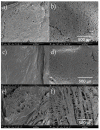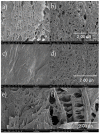Synthesis and Characterization of Poly(Vinyl Alcohol)-Chitosan-Hydroxyapatite Scaffolds: A Promising Alternative for Bone Tissue Regeneration
- PMID: 30241366
- PMCID: PMC6222900
- DOI: 10.3390/molecules23102414
Synthesis and Characterization of Poly(Vinyl Alcohol)-Chitosan-Hydroxyapatite Scaffolds: A Promising Alternative for Bone Tissue Regeneration
Abstract
Scaffolds can be considered as one of the most promising treatments for bone tissue regeneration. Herein, blends of chitosan, poly(vinyl alcohol), and hydroxyapatite in different ratios were used to synthesize scaffolds via freeze-drying. Mechanical tests, FTIR, swelling and solubility degree, DSC, morphology, and cell viability were used as characterization techniques. Statistical significance of the experiments was determined using a two-way analysis of variance (ANOVA) with p < 0.05. Crosslinked and plasticized scaffolds absorbed five times more water than non-crosslinked and plasticized ones, which is an indicator of better hydrophilic features, as well as adequate resistance to water without detriment of the swelling potential. Indeed, the tested mechanical properties were notably higher for samples which were undergone to crosslinking and plasticized process. The presence of chitosan is determinant in pore formation and distribution which is an imperative for cell communication. Uniform pore size with diameters ranging from 142 to 519 µm were obtained, a range that has been described as optimal for bone tissue regeneration. Moreover, cytotoxicity was considered as negligible in the tested conditions, and viability indicates that the material might have potential as a bone regeneration system.
Keywords: cell differentiation; cell proliferation; chitosan; poly(vinyl alcohol); scaffolds.
Conflict of interest statement
The authors declare no conflict of interest.
Figures









Similar articles
-
Development of genipin-crosslinked and fucoidan-adsorbed nano-hydroxyapatite/hydroxypropyl chitosan composite scaffolds for bone tissue engineering.Int J Biol Macromol. 2019 May 1;128:973-984. doi: 10.1016/j.ijbiomac.2019.02.010. Epub 2019 Feb 8. Int J Biol Macromol. 2019. PMID: 30738901
-
Nanofibrous poly(vinyl alcohol)/chitosan contained carbonated hydroxyapatite nanoparticles scaffold for bone tissue engineering.Mater Sci Eng C Mater Biol Appl. 2020 Feb;107:110347. doi: 10.1016/j.msec.2019.110347. Epub 2019 Oct 23. Mater Sci Eng C Mater Biol Appl. 2020. PMID: 31761152
-
Biocomposite scaffolds for bone regeneration: Role of chitosan and hydroxyapatite within poly-3-hydroxybutyrate-co-3-hydroxyvalerate on mechanical properties and in vitro evaluation.J Mech Behav Biomed Mater. 2015 Nov;51:88-98. doi: 10.1016/j.jmbbm.2015.06.032. Epub 2015 Jul 15. J Mech Behav Biomed Mater. 2015. PMID: 26232670
-
Chitosan-hydroxyapatite composites.Carbohydr Polym. 2013 Mar 1;93(1):256-62. doi: 10.1016/j.carbpol.2012.06.004. Epub 2012 Jun 20. Carbohydr Polym. 2013. PMID: 23465927 Review.
-
Genipin-Crosslinked Chitosan Gels and Scaffolds for Tissue Engineering and Regeneration of Cartilage and Bone.Mar Drugs. 2015 Dec 11;13(12):7314-38. doi: 10.3390/md13127068. Mar Drugs. 2015. PMID: 26690453 Free PMC article. Review.
Cited by
-
Multifunctional Hemostatic PVA/Chitosan Sponges Loaded with Hydroxyapatite and Ciprofloxacin.ACS Omega. 2022 Apr 11;7(15):13210-13220. doi: 10.1021/acsomega.2c00654. eCollection 2022 Apr 19. ACS Omega. 2022. PMID: 35474822 Free PMC article.
-
PVA/Chitosan Thin Films Containing Silver Nanoparticles and Ibuprofen for the Treatment of Periodontal Disease.Polymers (Basel). 2022 Dec 20;15(1):4. doi: 10.3390/polym15010004. Polymers (Basel). 2022. PMID: 36616354 Free PMC article.
-
Investigating the Promising P28 Peptide-Loaded Chitosan/Ceramic Bone Scaffolds for Bone Regeneration.Molecules. 2024 Sep 5;29(17):4208. doi: 10.3390/molecules29174208. Molecules. 2024. PMID: 39275056 Free PMC article.
-
Hydroxyapatite Obtained via the Wet Precipitation Method and PVP/PVA Matrix as Components of Polymer-Ceramic Composites for Biomedical Applications.Molecules. 2021 Jul 14;26(14):4268. doi: 10.3390/molecules26144268. Molecules. 2021. PMID: 34299547 Free PMC article.
-
The Diamond Concept Enigma: Recent Trends of Its Implementation in Cross-linked Chitosan-Based Scaffolds for Bone Tissue Engineering.ACS Appl Bio Mater. 2023 Jul 17;6(7):2515-2545. doi: 10.1021/acsabm.3c00108. Epub 2023 Jun 13. ACS Appl Bio Mater. 2023. PMID: 37310896 Free PMC article. Review.
References
-
- Jagur-Grodzinski J. Polymers for tissue engineering, medical devices, and regenerative medicine. Concise general review of recent studies. Polym. Adv. Technol. 2006;17:395–418. doi: 10.1002/pat.729. - DOI
-
- O’Brien F.J. Biomaterials & scaffolds for tissue engineering. Mater. Today. 2011;14:88–95.
-
- Sabir M.I., Xu X., Li L. A review on biodegradable polymeric materials for bone tissue engineering applications. J. Mater. Sci. 2009;44:5713–5724. doi: 10.1007/s10853-009-3770-7. - DOI
-
- Buckwalter J.A., Glimcher M.J., Cooper R.R., Recker R. Bone biology. I: Structure, blood supply, cells, matrix, and mineralization. Instruct. Course Lect. 1996;45:371–386. - PubMed
MeSH terms
Substances
LinkOut - more resources
Full Text Sources
Other Literature Sources

